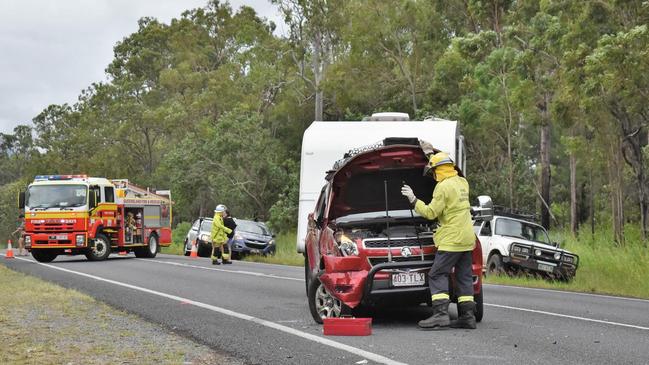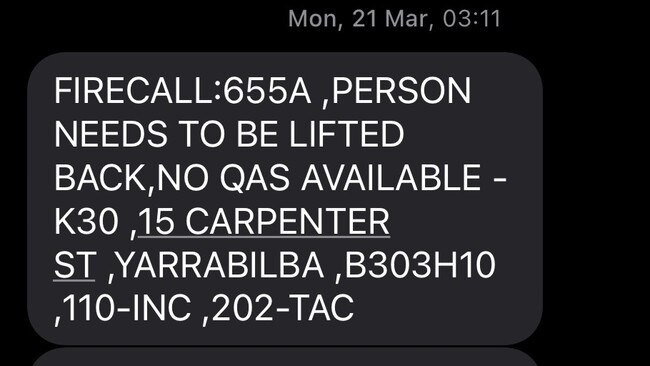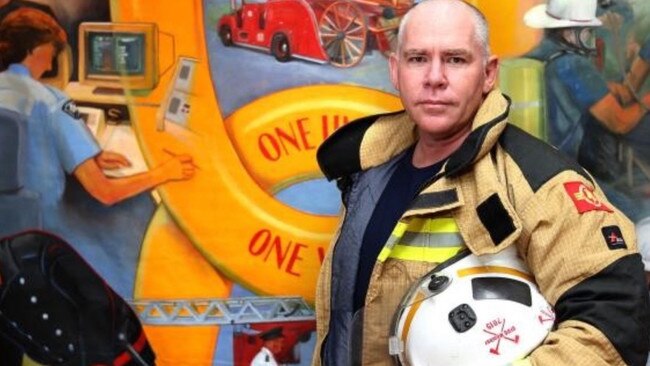Firefighters sent thousands of requests to fill in for overworked ambos
A former firefighter has said the state’s ambulance system is not coping after he had to step in to the role of paramedic and help a seriously injured woman when an ambulance took 40 minutes to arrive at an emergency.

Logan
Don't miss out on the headlines from Logan. Followed categories will be added to My News.
The state’s professional firefighters have been told to take up the slack and fill the shortfall of the Queensland Ambulance Service when an paramedic team is unavailable or delayed.
Hundreds of requests from the ambulance service to firefighters have been lodged this year via Firecom, the state’s fire communications centres.
QAS said it had requested assistance from QFES for approximately 4500 incidents this year and had 1500 requests from QFES.
Both services said they worked collaboratively when responding to incidents and followed protocols set out in a 2014 agreement to provide mutual emergency response assistance.
Common QFES requests to the ambulance service included help to extricate a patient from a significant road traffic crash.
The issue was discussed at a United Firefighters Union Queensland meeting in Beenleigh in June when professional firefighters complained they were not protected when directed to undertake the role of a paramedic.
Firefighters at the meeting were issued a copy of the 2014 memorandum of understanding and were told to alert the union in writing if there were breaches, with more than 20 responses recorded.
An SEQ firefighter, who did not want to be named, said he had attended many calls where he was required to fill the role of an ambulance officer because QAS was “short staffed”.

He said he decided to speak out about the QAS and QFES situation after his former team attended an horrific car crash in the Gold Coast hinterland in June.
He said the crew and a police officer from Logan District discussed putting the injured woman into the back of a police car and driving her to hospital as it took ambulances more than 40 minutes to arrive at the scene.
“There were volunteer firefighters at the scene who were holding this woman’s seriously broken legs — it was highly traumatic and should not have been dealt with this way as the crash was within 10 minutes from the Yarrabilba Ambulance Station,” he said.
“Firefighters, in particular the volunteers and the auxiliary employees, should not have to carry the burden of taking on these emergency jobs — we are not paramedics.”
The firefighter said QAS was also operating ambulances with only one person and when they arrived at an emergency, they relied on a firefighter or police officer for help.
Other jobs that the firefighter said his team was directed to attend in a medical capacity included helping an injured elderly person in Yarrabilba who had fallen out of a chair and was on the floor in March.
He said the team had also rung QPS from the scene of a crash at Beaudesert-Beenleigh Rd to find out when they would attend and was told to wait for the next shift for a police officer.
UFUQ state secretary John Oliver said firefighters taking on the role of a paramedic was “all too prevalent” and the situation was getting worse across the state.

“Clearly, pressure is on QAS and their response model is under strain,” he said.
“Currently, there are other agencies such as police and firefighters attending emergencies without QAS and they have been dealing with the medical casualties.
“Reports coming from firefighters responding to these emergencies are becoming more frequent and this tells me that there must be a resourcing issue within QAS.
“UFUQ met with QFES to discuss the issues in August and discussions are ongoing to ensure we do not turn into a quasi ambulance service.”
Whistleblowers and patients from across the state had shared stories at Queensland Health Crisis Town Halls this month.
Shadow Minister Fire and Emergency Services Dale Last said the practice creeping into the cities was a major development for the health crisis and was alarming.
“Queenslanders will now have concerns that not only could an ambulance not come in their hour of need, but minutes could be wasted when they need a firefighter who is tied up driving an ambulance,” he said.
“This is complete and utter chaos caused by a failure to plan by the government which has now been in power for nearly eight years.”
Quarterly statistics show hospital beds have been cut and ramping has increased from 15 per cent to 46 per cent, the worst in the nation.
In some parts of Queensland, patients are waiting more than seven hours on the back of a ramped ambulance before receiving a bed.
Mr Last said paramedics did not sign up to sit in the back of an ambulance for an entire shift when other Queenslanders were calling triple-0.
Originally published as Firefighters sent thousands of requests to fill in for overworked ambos



